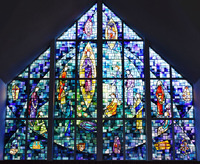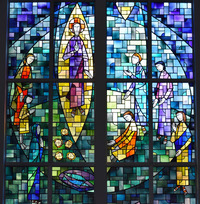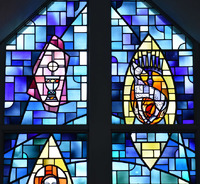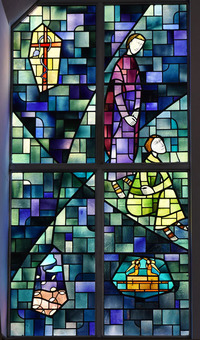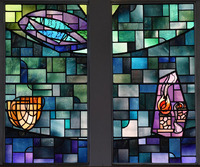Window
Building Name: Holy Name ChurchStudio Name: Detroit Stained Glass Works, The
City: Birmingham
Date of Window: 1955
Subject/Title of Window: Jesus Feeds the Five Thousand
Brief Description of Subject: The focal point of this transept window is the Feeding of the Five Thousand as told in Mark 6:1-14. A boy with five barley loaves and two small fish is offering them to Christ who is pictured taking the loaves and giving thanks. After the five thousand had finished eating they gathered the remains and filled twelve baskets --- a basket is seen below the fish. The artist has added the Blessed Virgin Mary to the scene dressed in her traditional blue. Surrounding the scene appears to be members of the five thousand.
Above the scene is found a Chalice and Host, the symbol of the Eucharist. Also seen is a lamb with seven golden lamp-stands. These are found in the Book of Revelation. The lamp-stands refer to the seven churches in Asia found in Chapters 1 -3, The lamb (Christ) is introduced as the one that is able to open the scroll with the seven seals.
Along the edges, starting on the left and moving counterclockwise are symbols based on writings in the Old Testament that point to the New Testament:
Snake around a cross. This comes from the story of the bronze serpent found in Numbers 21:4-9 --- In their passage through the desert the Israelites raised God's ire with their complaints and sent poisonous snakes that bit people and many died. Moses appealed for mercy for the people and God told Moses to make a bronze serpent and lift it up on a pole, everyone that was bitten that looked at it would live. The bronze serpent is a type of Christ --- Jesus' words to Nicodemus as recorded in John 3:14-15, "Just as Moses lifted up the serpent in the wilderness, so the Son of Man must be lifted up, that everyone who believes in him may have eternal life."
Manna falling from a cloud (God's place in Exodus). The story of manna is told in Exodus 16 --- While camping out in the wilderness, the Israelites complained about the lack of food. Moses told the Lord about this and the "The Lord said to Moses, 'Behold I will rain bread from heaven for you' ... in the morning flakes like frost ... appeared on the desert ground ... Moses said, 'This is the bread the Lord has given you' ... The people of Israel called the bread, manna." This is used by Christ in John 6:49-51, "Your fathers ate the manna in the wilderness and they died ... I am the living bread which came down from heaven, if anyone eats of this bread, he will live forever."
Ark of the Covenant. This is a type of Christ for many reasons. The contents of the Ark: a) manna, bread provided by God to feed the Israelites on their journey through the wilderness --- Christ is the bread of life, b) rod of Aaron used to chose the High Priest and worked miracles --- Christ is the High Priest and works miracles. c) tablets of the Ten Commandments, the Old Covenant --- Christ is the New Covenant. The top of the Ark is called the "mercy seat" where blood sacrifices were made for the atonement of sin --- Christ sacrificed himself for the forgiveness of sin.
Smoke rising from one altar and sinking from another. This is from Cain and Abel's burnt offerings to God as found in Genesis 4:2-5, Abel worked with sheep and offered up a first born to God while Cain offered up fruits of the soil. "The Lord looked with favor on Abel and his offering, but Cain and his offering he did not look with favor." This is seen by the smoke from Abel's burnt offering rising while Cain's is not. In Hebrew 11:4, "By faith Abel offered to God a better sacrifice than Cain did. By faith he was commended as a righteous man, when God spoke well of his offering. And by faith he still speaks, even though he is dead."
Altar. The Torah prescribed that an altar be built for burnt offerings that must be made to God for the atonement of sin. In the New Testament the cross was the altar on which Christ was sacrificed for our sin. Note, this is why in the Holy Sacrifice of the Mass, an altar is required.
Tree of Life. In Genesis 3:22 - 23, after eating from the forbidden tree of knowledge, the Lord said,"The man has become like one of us, knowing good and evil. He must not be allowed to reach out his hand and take also from the tree of life and eat, and live forever. So the Lord God banished him from the Garden of Eden." In Revelation 2:7, The Lord said, "He who has an ear, let him hear what the Spirit says to the Churches. To the ones who conquer, I will grant them to eat from the tree of life, which is in the paradise of God."
A Jesse Tree. The genealogy of Christ is important as it fulfills the Davidic Covenant that the Messiah would be a descendant of David. A tree-like representation of that genealogy is called a "Jesse Tree." This idea comes from Isaiah 11:1, referring to the Messiah, " And a shoot will come from the stump of Jesse [father of David]; from his roots a branch will bear fruit [the Messiah]. The Jesse Tree was a popular subject for illuminated manuscripts and stained glass. One of the most renowned in stained glass is found at Chartres Cathedral.
This window was designed by Margaret Bouchez Cavanaugh when she worked at the Detroit Stained Glass Works.
Condition of Window: Good
Height: 30'
Width: 32'
Type of Glass and Technique: Antique or Cathedral Glass
Jesus Feeds the Five Thousand
Jesus Feeds the Five Thousand close-up
Chalice and Host, Lamb and Seven Golden Lamp-stands
Snake Around a Cross, Manna Falling From a Cloud, Ark of the Covenant
Two Fish, Basket, Smoke Rising
Altar, Tree of Life, Jesse Tree
The MSGC is a constantly evolving database. Not all the data that has been collected by volunteers has been sorted and entered. Not every building has been completely documented.
All images in the Index are either born-digital photographs of windows or buildings or are scans of slides, prints, or other published sources. These images have been provided by volunteers and the quality of the material varies widely.
If you have any questions, additions or corrections, or think you can provide better images and are willing to share them, please contact donald20@msu.edu

